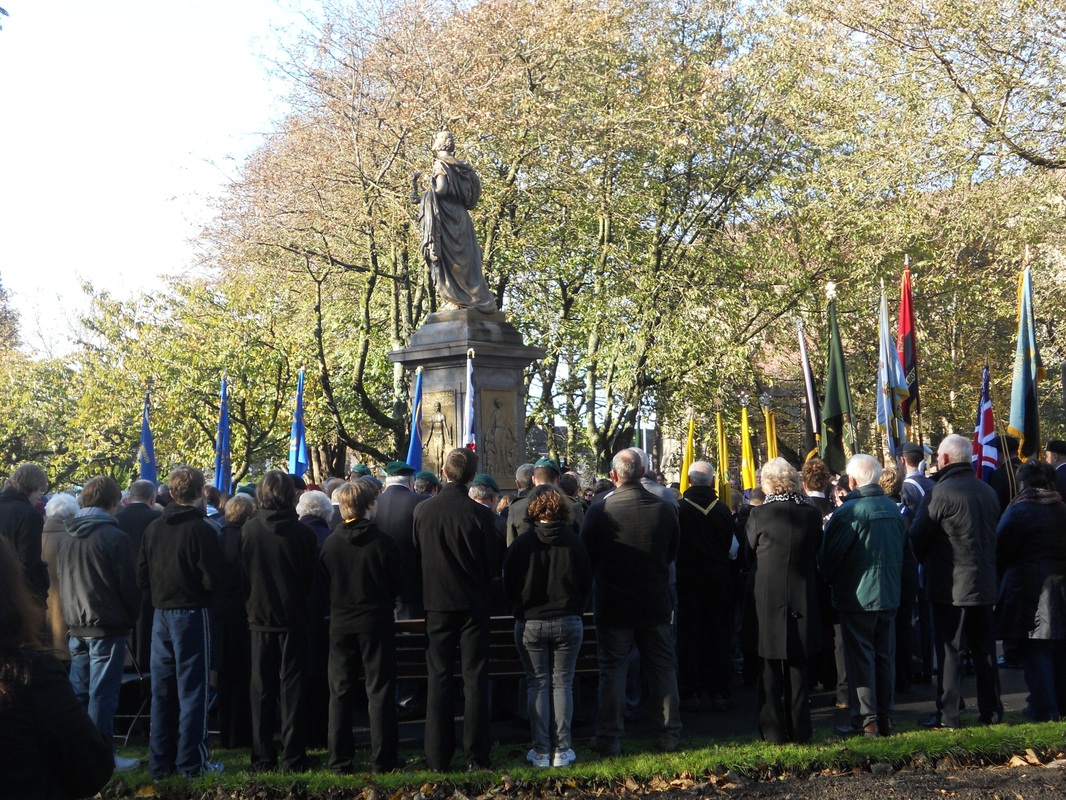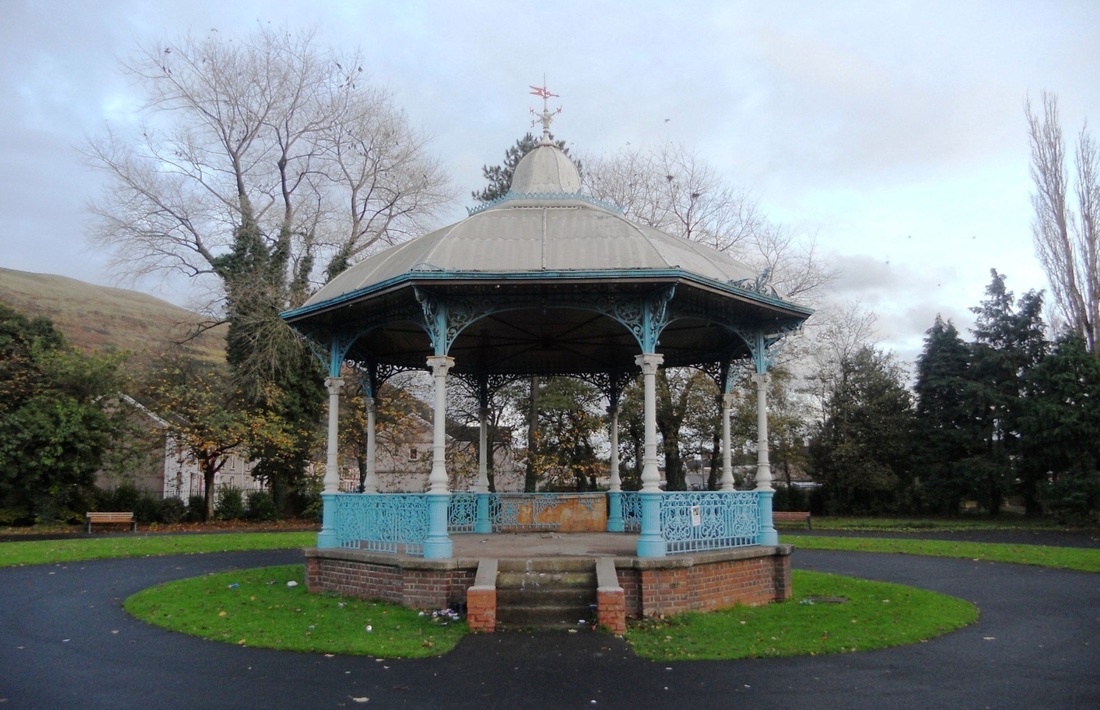I've recently come back from a 10 day stay in Port Talbot, a busy and eclectic trip that saw me walking footpaths, beaches and streets, attending a Public Inquiry, the official launch of Real Port Talbot, a book-signing (with cupcakes!) and the annual Remembrance Parade.
It was the first time I'd walked the mile or so route from the Civic Centre to the Talbot Memorial Park alongside the bands and regiments, members of the Royal British Legion, councillors, scouts, a Welsh Assembly Member and an MP, in some places squeezing past the crowds lining Station Road, Talbot Road and Commercial Road. And hundreds of other people chose to do the same in the sharp November sunlight, the air crisp, the ground underfoot dry and safe. And then we stood still. In silence.
It was the first time I'd walked the mile or so route from the Civic Centre to the Talbot Memorial Park alongside the bands and regiments, members of the Royal British Legion, councillors, scouts, a Welsh Assembly Member and an MP, in some places squeezing past the crowds lining Station Road, Talbot Road and Commercial Road. And hundreds of other people chose to do the same in the sharp November sunlight, the air crisp, the ground underfoot dry and safe. And then we stood still. In silence.
Remembrance has nothing to do with religion or war, being a soldier or a pacifist. A minute's silence is a minute gifted to the memory and respect of people we have known and lost, and to people who we didn't know but whose hearts and minds fought for something that made a difference to our lives no matter how long ago.
The park is an ideal place to remember, to reflect. Walk around on your own or in company. Try and be silent for a while too. It's a commodity that's becoming increasingly rare in our lives.
The park is an ideal place to remember, to reflect. Walk around on your own or in company. Try and be silent for a while too. It's a commodity that's becoming increasingly rare in our lives.
Excerpt from Real Port Talbot pp.191-193
Talbot Memorial Park
A window on the south side of the church [St Theodore's] commemorates Lieutenant Rupert Price Hallowes MC VC who was killed in Flanders in 1915, Port Talbot’s only Victoria Cross. Hallowes, who was an assistant manager at the Mansel Tinplate Works in Aberafan, is remembered again in the gateway[i] to the Talbot Memorial Park next door. The gateway was built, along with its brace of lodges, in 1925 and the park, an open space of over 12 acres donated by Emily Talbot in 1902[ii] and dedicated as a memorial to those who died in WWI in 1919[iii], was formally laid out and officially opened to the public in June 1926.
The theme of remembering is reinforced by another war memorial[iv] as you walk into the park; the bronze work is by Louis Frederick Roslyn[v], a British sculptor noted for his WWI memorials. Roslyn was born Roselieb in London in 1878 although by 1914 he had, understandably, changed his name to something less Germanic.
There’s more remembrance in the park’s right-hand corner: a drinking fountain[vi] in honour of Dr John Hopkin Davies who came to Taibach at the request of Theodore Talbot in 1872 and practised there for 48 years. It was moved to the park in 1926 but had been erected in 1910, a decade before his death: a heartfelt tribute from the people of Taibach, paid for by public subscriptions. The mood of genuine veneration might have been somewhat marred at the original unveiling ceremony by an unscripted announcement from Sir A.P. Vivian, manager of the Taibach Copper Mill, that he would close the mill if men on strike at the time didn’t return to work the following Monday. I don’t know whether that event soured Dr Davies’ appreciation of the fountain but there’s a story in Outline of a Welsh Town[vii] which records how he drew down the blind on his coach every time he rode past. Although the fountain’s similarity to a tombstone couldn’t have helped either.
There’s a cracking octagonal bandstand[viii] in the centre of the park that Cadw have, fortunately, listed as, ‘an increasingly scarce building type.’ It wouldn’t be that scarce if two other bandstands in Port Talbot hadn’t already disappeared in puffs of demolition dust.[ix]
The latest addition to the theme of remembrance drapes itself over the grass nearby. The Richard Burton Memorial Flower Bed was unveiled on 9th November 2012, the day before what would have been Burton’s 87th birthday, by Dr Hywel Francis, MP for Aberafan. A flower bed might not be most people’s idea of a permanent memorial, given the vagaries and moods of weather and delinquents, but it’s a relief to see a cheery, organic memorial rather than another hunk of sculpted stone and brass. Kids from local schools helped in its design and planting and the production of a leaflet for a new section of the Richard Burton Trail[x], the Childhood Trail, which circles Taibach and some of Burton’s homes and haunts.
[i] Cadw record 23255
[ii] Minutes of the Margam District Urban Council 9.2.1902/3?
[iii] Ibid 16.7.1919
[iv] Cadw record 23256
[v] http://en.wikipedia.org/wiki/Louis_Frederick_Roslyn
[vi] Cadw record 23257
[vii] Hanson, Outline p.91
[viii] Cadw record 23258
[ix] A bandstand on Aberafan Beach was removed for the construction of the first promenade c.1900. The bandstand in Vivian Park, Sandfields Estate, was dismantled in the late 1960s.
[x] NPTCBC - http://tiny.cc/gh8dqw
Talbot Memorial Park
A window on the south side of the church [St Theodore's] commemorates Lieutenant Rupert Price Hallowes MC VC who was killed in Flanders in 1915, Port Talbot’s only Victoria Cross. Hallowes, who was an assistant manager at the Mansel Tinplate Works in Aberafan, is remembered again in the gateway[i] to the Talbot Memorial Park next door. The gateway was built, along with its brace of lodges, in 1925 and the park, an open space of over 12 acres donated by Emily Talbot in 1902[ii] and dedicated as a memorial to those who died in WWI in 1919[iii], was formally laid out and officially opened to the public in June 1926.
The theme of remembering is reinforced by another war memorial[iv] as you walk into the park; the bronze work is by Louis Frederick Roslyn[v], a British sculptor noted for his WWI memorials. Roslyn was born Roselieb in London in 1878 although by 1914 he had, understandably, changed his name to something less Germanic.
There’s more remembrance in the park’s right-hand corner: a drinking fountain[vi] in honour of Dr John Hopkin Davies who came to Taibach at the request of Theodore Talbot in 1872 and practised there for 48 years. It was moved to the park in 1926 but had been erected in 1910, a decade before his death: a heartfelt tribute from the people of Taibach, paid for by public subscriptions. The mood of genuine veneration might have been somewhat marred at the original unveiling ceremony by an unscripted announcement from Sir A.P. Vivian, manager of the Taibach Copper Mill, that he would close the mill if men on strike at the time didn’t return to work the following Monday. I don’t know whether that event soured Dr Davies’ appreciation of the fountain but there’s a story in Outline of a Welsh Town[vii] which records how he drew down the blind on his coach every time he rode past. Although the fountain’s similarity to a tombstone couldn’t have helped either.
There’s a cracking octagonal bandstand[viii] in the centre of the park that Cadw have, fortunately, listed as, ‘an increasingly scarce building type.’ It wouldn’t be that scarce if two other bandstands in Port Talbot hadn’t already disappeared in puffs of demolition dust.[ix]
The latest addition to the theme of remembrance drapes itself over the grass nearby. The Richard Burton Memorial Flower Bed was unveiled on 9th November 2012, the day before what would have been Burton’s 87th birthday, by Dr Hywel Francis, MP for Aberafan. A flower bed might not be most people’s idea of a permanent memorial, given the vagaries and moods of weather and delinquents, but it’s a relief to see a cheery, organic memorial rather than another hunk of sculpted stone and brass. Kids from local schools helped in its design and planting and the production of a leaflet for a new section of the Richard Burton Trail[x], the Childhood Trail, which circles Taibach and some of Burton’s homes and haunts.
[i] Cadw record 23255
[ii] Minutes of the Margam District Urban Council 9.2.1902/3?
[iii] Ibid 16.7.1919
[iv] Cadw record 23256
[v] http://en.wikipedia.org/wiki/Louis_Frederick_Roslyn
[vi] Cadw record 23257
[vii] Hanson, Outline p.91
[viii] Cadw record 23258
[ix] A bandstand on Aberafan Beach was removed for the construction of the first promenade c.1900. The bandstand in Vivian Park, Sandfields Estate, was dismantled in the late 1960s.
[x] NPTCBC - http://tiny.cc/gh8dqw




 RSS Feed
RSS Feed